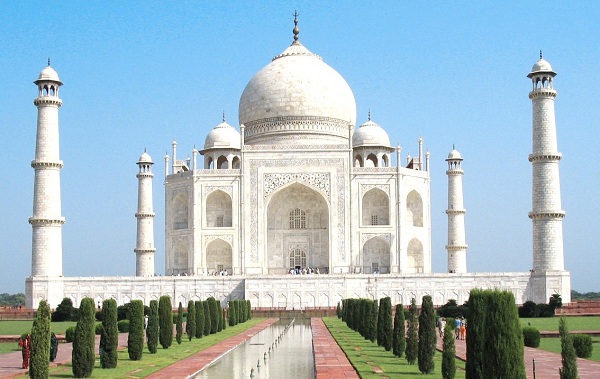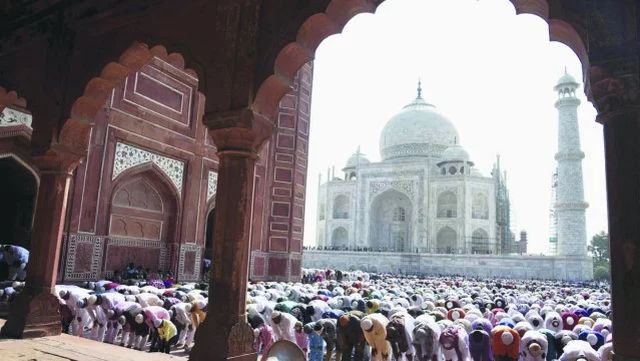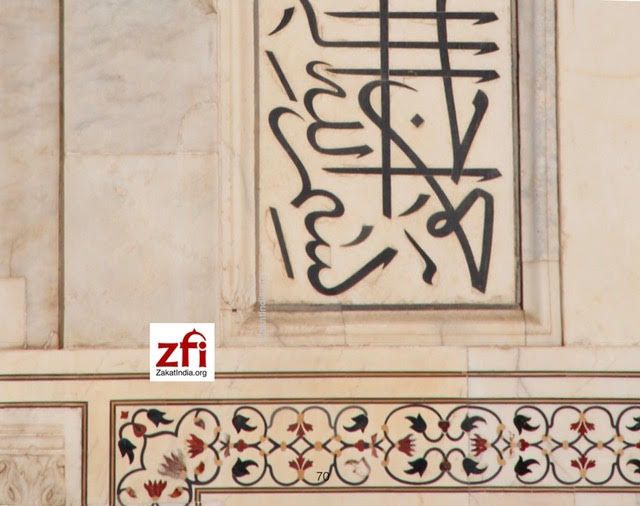
by admin | May 25, 2021 | News, Politics
 By Shuriah Niazi,
By Shuriah Niazi,
New Delhi: Muslims in Indian city of Agra would no longer be able to offer prayers at the mosque situated on the premises of landmark Taj Mahal except on Fridays.
According to the directives issued by the Archaeological Survey of India, Muslims will be allowed to offer prayers at the Taj Mahal mosque only on Fridays.
The decision was taken in accordance with the order of the Supreme Court of India, Vasant Swarankar, superintending archaeologist at ASI’s Agra chapter, told the Times of India, a local daily.
“Namaz (prayer) can only be offered on Fridays and that, too, by local residents only,” Swarankar said.
Syed Ibrahim Hussain Zaidi, president of the mosque’s management committee, termed the decision as an “anti-Muslim” move.
“This show their mindset. The order is illegal and you cannot prohibit residents from offering prayers on other days,” Zaidi told Anadolu Agency.
Earlier in July, The Supreme Court of India had refused to allow prayers by outsiders at the mosque on the premises of the Taj Mahal, saying the monument’s preservation is paramount.
The court has said that the Taj Mahal is one of the seven wonders of the world and people have several other mosques to offer their prayers.
The Taj Mahal is a 16th century marble mausoleum built by the Mughal emperor Shah Jahan in memory of his wife. Thousands of people visit Agra every year to see the famous Taj Mahal.
The mosque there remains closed on Fridays for the general public. The locals are allowed to offer prayer at the mosque between noon and 2 pm on Fridays after showing identity proof.
—AA

by admin | May 25, 2021 | Corporate, Corporate Governance, News, Politics
 New Delhi : Slamming both the Central and Uttar Pradesh government for the neglect of Taj Mahal, the Supreme Court on Thursday wondered what if Unesco drops the 17th century Mughal monument from its list of world heritage sites.
New Delhi : Slamming both the Central and Uttar Pradesh government for the neglect of Taj Mahal, the Supreme Court on Thursday wondered what if Unesco drops the 17th century Mughal monument from its list of world heritage sites.
“It is a world heritage site. What will happen if Unesco say that we withdraw the world heritage title,” asked the bench of Justice Madan B. Lokur and Justice Deepak Gupta.
Asked if the authorities concerned have filed the management plan for the protection and preservation of the heritage site, Justice Lokur said: “It is very very difficult to understand something that is happening. Something is said on affidavit, something is said orally and something otherwise. It is unacceptable.
Coupled with this, the court also wanted to know which was the authority responsible for the protection and preservation of Taj as it found that the three affidavits filed before it were by the Uttar Pradesh Tourism Department, second by the Union Environment and Forest Ministry and third by some other authority.
“Somebody has to take the responsibility. Who has to take the responsibility for Taj – either Centre or Uttar Pradesh government with an identifiable authority?” the bench said.
As senior counsel A.D.N.Rao told the court that the Archaeological Survey of India was responsible for the Taj, the court expressed surprise that the it has been kept out of the consultation process for preparing the draft vision document for the protection and preservation of the Taj.
Ordering that a copy of the draft vision document be made available to the ASI and asking its to share it with INTACH, Agha Khan Foundation, ICOMS and other similar entities who have expertise in protecting and restoring the historic monuments, the court also directed the UP government to give a copy of the vision document to petitioner M.C.Mehta for his comments.
Sharing the court’s concern on the possibility of Unesco dropping Taj from the list of world heritage sites, Attorney General K.K. Venugopal told the court that the task involving the preservation and protection of Taj and other adjoining monuments including Agra Fort, Fatehpur Sikri and Sikandra fort at Mathura Ais massive and has to be carried by way of short term, medium and long term plan.
He told the court that short term plan itself would take two years to complete.
At the outset of the hearing, Justice Lokur took exception to Uttar Pradesh government filing the draft vision document asking if the state government expected the Court to “correct it.”
The court was told that the Taj Trapezium Authority was responsible for executing the larger plans fior the protection of heritage monument, Justice Lokur said had it been doing its job, things would not have come to such a pass.
The court directed it be told “categorically and unequivocally” who is responsible for the TTZ.
“Whether it is Union of India, then which Ministry, if it is Uttar Pradesh government, then which Ministry,” said Justice Lokur, adding that “we are in a situation where left hand does not know what right is doing”.
TTZ is an area of about 10,400 sq km spread over the districts of Agra, Firozabad, Mathura, Hathras and Etah in Uttar Pradesh and Bharatpur district of Rajasthan.
As the Attorney General referred to the draft vision document involving multi-pronged approach to preserve and protect the heritage monument, Justice Lokur confronted him with an affidavit by the Uttar Pradesh government which said that there were 1,167 polluting industries in the area.
Venugopal then sought to clarify that all of them were being operated on clean fuel and UP government’s standing counsel Aishwarya Bhati said it was just the nomenclature to describe them which is in use for long.
This drew the court’s ire.
“They are polluting industries, your affidavit says but you are saying that they are not polluting but by nomenclature they have been described so,” said Justice Lokur.
“There is something wrong with your English or there is something wrong with ours,” he added.
—IANS

by admin | May 25, 2021 | News, Politics
 New Delhi : The Supreme Court on Wednesday came down heavily on the Centre and the Archaeological Survey of India (ASI) for not being able to protect the iconic Taj Mahal, asking to “shut it down” or “demolish or restore” the Mughal structure.
New Delhi : The Supreme Court on Wednesday came down heavily on the Centre and the Archaeological Survey of India (ASI) for not being able to protect the iconic Taj Mahal, asking to “shut it down” or “demolish or restore” the Mughal structure.
The apex court was unhappy as the Uttar Pradesh government failed to come out with a vision document to protect the Taj Mahal.
A bench of Justice Madan B. Lokur and Justice Deepak was upset with the authorities for not taking any step to preserve the Taj Mahal and said its “sheer lethargy” on the part of the authorities.
“There is absolutely no willingness to protect the Taj Mahal. Pristine beauty of Taj Mahal has to be protected. You can shut down the Taj Mahal it demolish it. Restore it if you want or demolish it if it has to be demolished,” said the bench.
The court said the Taj Mahal is more beautiful than the Eiffel Tower and could have solved the country’s foreign exchange problem.
“There is the Eiffel Tower in Paris. Perhaps it is nothing compared to Taj Mahal. Our Taj Mahal is more beautiful. 80 million go to watch Eiffel Tower which looks like a TV Tower. This is eight times more than what we have. If you had looked after it, your foreign exchange problem would have been solved.
“Do you realise the loss caused to the country due to your apathy?,” observed the bench.
The Uttar Pradesh government had earlier told the bench that it would place before the court a draft of vision document on protection and preservation of the Taj Mahal that was built by Emperor Shah Jahan in memory of his beloved wife Mumtaz Mahal.
Saying it would hear the case next on July 31 on a day-to-day basis, the bench told the Central government to furnish full details of the steps taken and action it intends to take for protecting the Taj Mahal along with time-frame and responsibility and accountability of the departments concerned.
During the hearing, the bench said that there was a report of the Parliamentary Standing Committee, which dealt with the effects of pollution on Taj Mahal, but the authorities have not bothered to take appropriate steps on the issue.
The Central government submitted that the Indian Institute of Technology, Kanpur was conducting an assessment of air pollution level in and around the Taj Mahal and Taj Trapezium Zone (TTZ) and the report would be given within four months.
The court also sought personal appearance of the chairman of Taj Trapezium Zone (TTZ) — a 10,400 sq km area spread over the districts of Agra, Firozabad, Mathura, Hathras and Etah in Uttar Pradesh and Bharatpur in Rajasthan — to explain violation of its orders prohibiting expansion of industrial units in the zone.
The Uttar Pradesh government had said it was also trying to take care of the environment around the structure so that the historic monument could be there for another 400 years and not just for a generation.
The court has been hearing a plea filed by environmentalist M.C. Mehta seeking protection of the Taj from the ill-effects of polluting gases and deforestation in and around the area.
—IANS

by admin | May 25, 2021 | News, Politics
 New Delhi : The Supreme Court on Monday refused to allow outsiders to offer ‘namaz’ at a mosque in the Taj Mahal premises, saying the historic monument, which is one of the seven wonders of the world, “must be protected”.
New Delhi : The Supreme Court on Monday refused to allow outsiders to offer ‘namaz’ at a mosque in the Taj Mahal premises, saying the historic monument, which is one of the seven wonders of the world, “must be protected”.
A bench headed by Justice A.K. Sikri and Justice Ashok Bhushan said there was no need to perform prayers at the Taj Mahal only as it dismissed a plea filed against Agra authorities’s order debarring outsiders from offering prayers on Fridays at the mosque inside the Taj Mahal complex.
“Why should people go to the Taj Mahal for prayers, there are other mosques also where they can offer their prayers,” asked the bench after petitioner Syed Ibrahim Hussain Zaidi, president of Taj Mahal Masjid Management Committee, contended that several tourists visit the city throughout the year and the order to restrain them from offering their prayers at the complex was “illegal”.
The district administration, to ensure foolproof security to the world heritage site, on January 24, ordered that only those with valid identity cards would be allowed entry to the monument complex to offer prayers on Fridays – when the Taj Mahal remains closed for tourists.
The order, which held that entry of outsiders could adversely affect the security of the monument, came following complaints that outsiders, including Bangladeshis and non-Indians, enter the Taj Mahal complex on Fridays on the pretext of offering prayers.
—IANS

by admin | May 25, 2021 | Business, Economy, News, Politics, SMEs
 By Brij Khandelwal,
By Brij Khandelwal,
Agra : The controversial Taj Heritage Corridor which brought down the Mayawati government in 2003 is being resurrected in a new avatar — but disturbing questions remain, environmentalists say.
The Uttar Pradesh horticulture department, in collaboration with the Archaeological Survey of India, has started greening the vast wasteland sandwiched between two world heritage monuments, the Taj Mahal and the Agra Fort, after the local MP and the chairman of the SC/ST Commission Ram Shankar Katheria laid the foundation stone of the new Taj View Garden a few days ago.
The Supreme Court, some 10 years ago, had asked the Archaeological Survey of India to clean up the debris from the corridor site and develop the 80 acres of reclaimed land as a green buffer to insulate the Taj Mahal from air pollution. But for want of resources, it took more than a decade for the work to start.
“We have laid a new lush green lawn and lined up ornamental plants. Come rainy season and the whole area would be a green delight and attract tourists,” UP horticulture department’s garden superintendent Mukesh Kumar said.
Agra Mayor Navin Jain has promised that the municipal corporation would extend the green frontiers and maintain the newly-developed park.
Once completed, the green stretch will be a new attraction for tourists.
Till recently the land was being used not only as a dumping ground for garbage but also as a place to bury bodies of children and aborted foetuses. The sprawling 80-acre platform, recovered through dredging of the river bed and refilling of the open space, was left unfinished after corruption charges were levelled against Mayawati. The charges eventually brought down her government.
The corridor was to begin from Khan-e-Alam, close to the Taj Mahal, and extend two kilometres towards the city behind the Agra Fort. It was to be extended later to allow tourists to reach Etmaddaula and Ram Bagh on the other side of the river.
For months, hundreds of tractors, earthmovers and machines worked round the clock to dig out silt and deposit it on the river bank to create a new platform, which was laid with Rajasthani stones.
The space was to be used to erect tall buildings, amusement parks, shopping malls and the like.
But, after a hue and cry from conservationists that the corridor would endanger the monument and allegations of large-scale corruption in the project, the Central government suspended the work in 2003. The alleged scandal reportedly involved government allotment of large tracts of land along the proposed corridor to a private builder for a song.
As the case against Mayawati dragged for years, the corridor remained an eyesore between two world heritage monuments. Scores of foreign tourists visit the site daily and take pictures that were not too flattering.
Environmentalists have on several occasions expressed concern at the alarming pollution level in the Yamuna after hundreds of truck-loads of waste, including carcasses of animals and bodies of children, was dumped into the river.
When tourists looked at the Taj Mahal from Agra Fort, what they saw was a disturbing sight — heaps of stinking garbage, carcasses and graves of children dotting the structure and mounds of rubble that invite mosquitoes, dogs, snakes, crows and vultures.
“Such an ugly sight near the world’s most beautiful monument can be repulsive and nauseating,” environmentalist Harendra Gupta said.
Rajiv Gupta, former president of the National Chamber of Industries and Commerce, thought that “a positive beginning has now been made and soon Agra will have a new tourist attraction”.
But local environmentalists point out that the so-called heritage corridor was, legally speaking, an encroachment on the Yamuna river bed. “That was the reason why work was stopped. Now instead of dismantling and removing the debris, they are seeking to legitimise an encroachment of public land,” said Shravan Kumar Singh of the Braj Mandal Heritage Conservation Society.
Eminent historian Prof R. Nath, who had first drawn attention to this controversial corridor back in 2002, told IANS on phone from Ajmer: “This corridor should be cleared and the Yamuna allowed to breathe free. Also, the artificial park created just behind the Taj Mahal on a mound of debris should be immediately cleared as it has distanced the river Yamuna which should flow touching the base of the monument. The powers that be should stop playing with monuments.”
(Brij Khandelwal can be contacted at brij.k@ians.in)
—IANS



